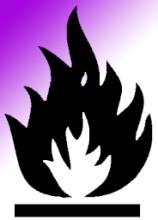Flammable and Combustible Liquids
April 2022
Purpose:
A flammable material is any liquid, solid or gas that will ignite easily and burn rapidly. Materials that are flammable are of concern due to their ability to render damage to property and more importantly, to injure or cause death of workers
Objective:
The storage, issue, use and disposal of flammable and combustible liquids falls under the rules and regulations promulgated under OSHA, the National Fire Protection Association and the Amherst College policy.
Responsibility
All users of flammable and combustible material must follow this section
Classification of Flammable and Combustible Liquids
"Flammable liquid" refers to any liquid having a flashing point below 100F. Such flammable are Class I liquids. These liquids are subdivided into three classes. The following is an illustrative list of common flammable liquids.
- ClassIA - Flash Point: Below 73 degrees F, Boiling Point: Below 100F
- ClassIB - Flash Point: Below 73 degrees F, Boiling Point: At or Above 100F
- ClassIC - Flash Point: At or Above 73 degrees F, Boiling Point: Below 100F
"Combustible liquids" refers to any liquid having a flash point at or above 100F. Combustible liquids are subdivided as follows:
- ClassII - Flash Points: At or Above 100 degrees F and below 140 degrees F.
- ClassIIIA - Flash Points: At or Above 140 degrees F and below 200 degrees F.
- ClassIIIB - Flash Point: At or Above 200 degrees F.
This data have been tabulated for easier reading.
*NFPA is the acronym for the National Fire Protection Association. NFPA 704, Standard System for the Identification of the Fire Hazards of Materials, provides planning guidance to fire departments for safe tactical procedures in emergency operations, and gives on-the-spot information to safeguard the lives of fire fighting personnel and the others who may be exposed. The Hazard Identification System is not intended to identify the non emergency health hazards of chemicals.
Definitions:
Laboratory Unit - An enclosed space used for experiments or tests. Laboratory units may or may not included offices, laboratories, and other contiguous rooms maintained for or used by laboratory personnel, and corridor within the unit. It may contain one or more separate laboratory work areas. It may be an entire building. It must, however, be separated from other building areas by appropriate fire resistive construction having at least a one hour fire resistive rating.
Requirements
Maximum quantities of flammable and combustible liquids in research laboratory units, general purpose laboratory units, and a laboratory units in health care facilities shall be in accordance with the following tables.
Maximum quantities of flammable and combustible liquids in instructional laboratory units shall not exceed 50% of that allowable indicated in the following tables.
MAXIMUM QUANTITIES OF FLAMMABLE AND COMBUSTIBLE LIQUIDS IN LABORATORY UNITS OUTSIDE OF APPROVED FLAMMABLE LIQUID STORAGE ROOMS.
- Excluding Quantities in Storage Cabinets and Safety Cans
Including Quantities in Storage Cabinets and Storage Cans
Liquid Class Maximum Quantity per 100 sq. ft.
of Lab UnitMaximum Quantity per Unit*** I* 7.5 L (2 gal) 284 L (75 gal) I,II, and IIIA** 15.0 L (4 gal) 380 L (100 gal) Notes:
Liquid Class Maximum Quantity per 100 sq. ft.
of Lab UnitMaximum Quantity per Unit*** I* 15.0 L (4 gal) 570 L (150 gal) I, II, IIA*** 30.0 L (8 gal) 760 L (200 gal)
*Class I liquid maximum shall be inclusive of Class IA, IB, and IC collectively.
**The maximum quantities of Class I liquids shall not exceed the quantities specified for Class I alone.
***The more restrictive quantity, based on either the Maximum Quantity per 100 sq. or Maximum Quantity per Lab Unit, shall apply to all cases.- Maximum allowable container size fore use in all laboratories shall be in accordance with the following table.
Flammable Liquids*** Combustible Liquids***Notes:
Container Type IA IB IC II IIA Glass 500 ml* 1.0 L* 4.0 L 4.0 L 20 L Metal or approved plastic 4.0 L 20 L 20 L 20 L 20 L Safety Cans 10 L 20 L 20 L 20 L 20 L Metal drums
(DOT spec.)0 20 L 20 L 227 L 227 L Polyethelene** 4.0 L 20 L 20 L 227 L 227 L
*Glass containers , as large as 4 L shall be permitted to be used if needed and if the required purity would be adversely affected by storage in a metal or an approved plastic container, or if the liquid would cause excessive corrosion or degradation of a metal or an approved plastic container.
**DOT Spec. 34, UN 1H1, or as authorized by DOT exemption.
***In instructional laboratory work areas, no container for Class I or Class II liquids shall exceeds a capacity of 4 L, except that safety cans shall be permitted to have an 8 L capacity.
- Flammable or combustible liquids shall not be stored in ordinary refrigerators. Storage of flammable or combustible liquids in well-sealed containers is permissible in approved flammable materials storage refrigerators or in refrigerators approved for Class I, Division I, Group C and D. The outside of doors to laboratory refrigerators shall be labeled to denote whether or not they are acceptable for storage of flammable or combustible liquids.
- Incompatible materials shall be segregated to prevent accidental contact with one another.
- Flammable and combustible liquids stored in the open in the laboratory work area shall be kept the minimum necessary for the work being conducted.
- All containers used for storage of flammable and combustible liquids shall be labeled as to content in accordance with good laboratory practice.
